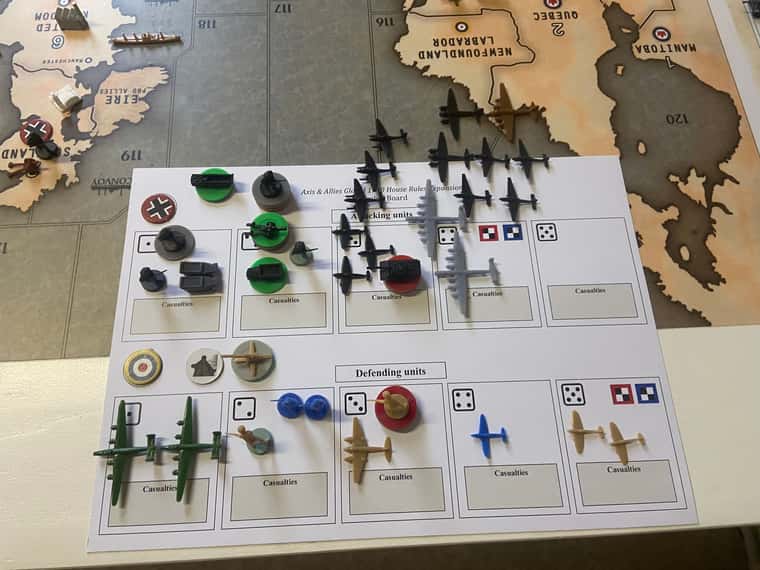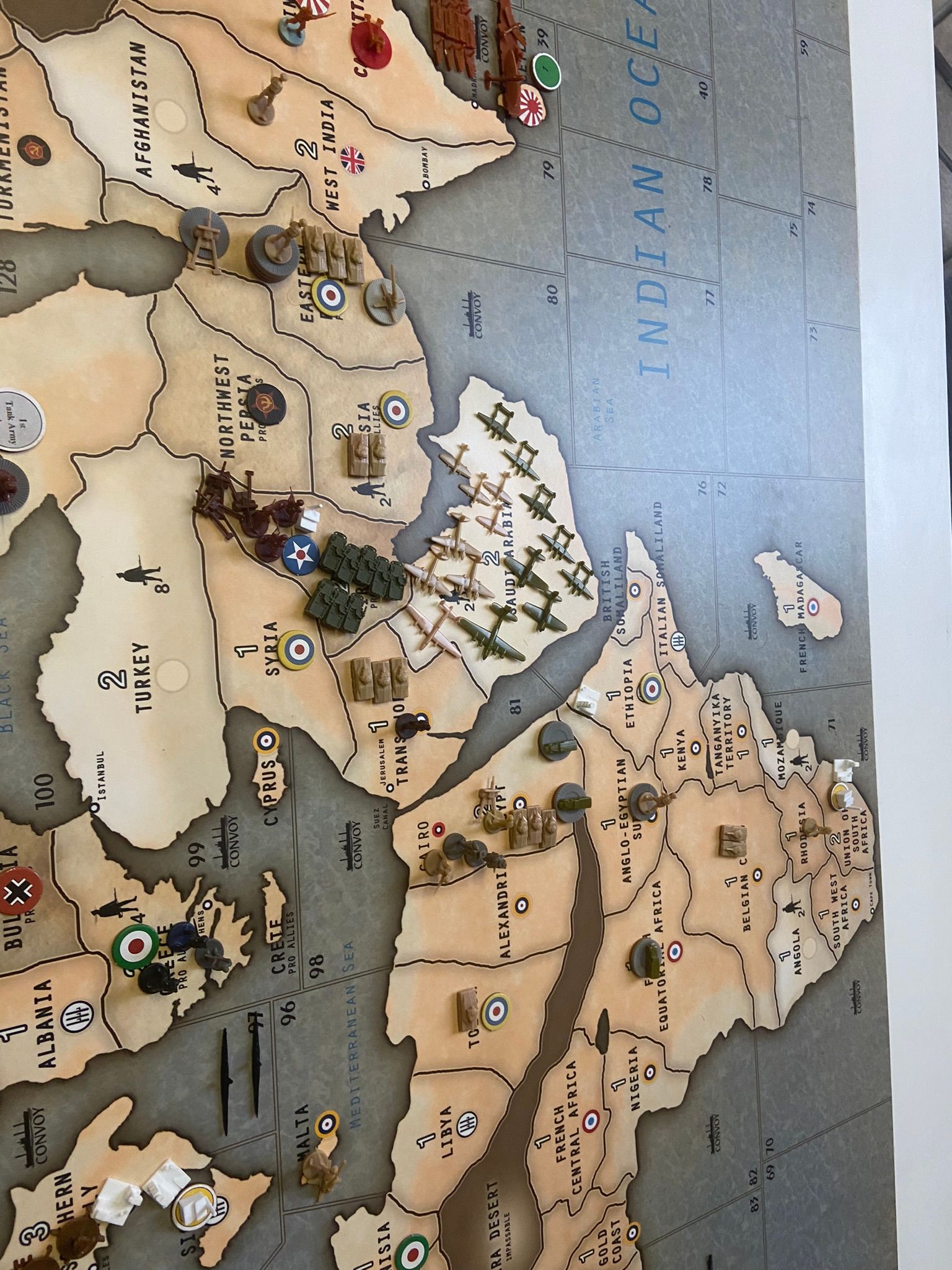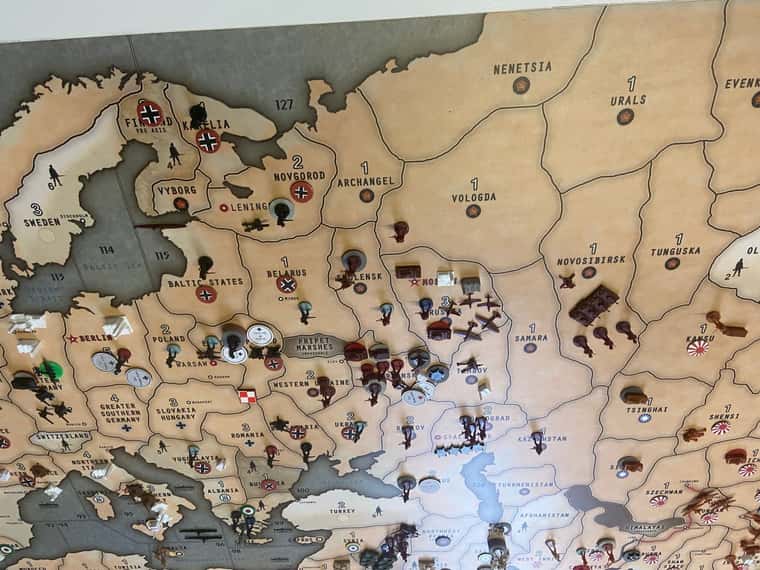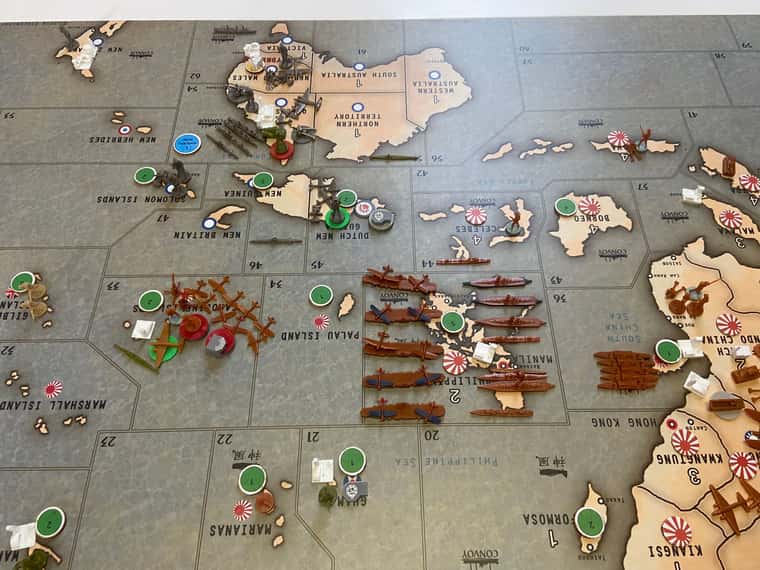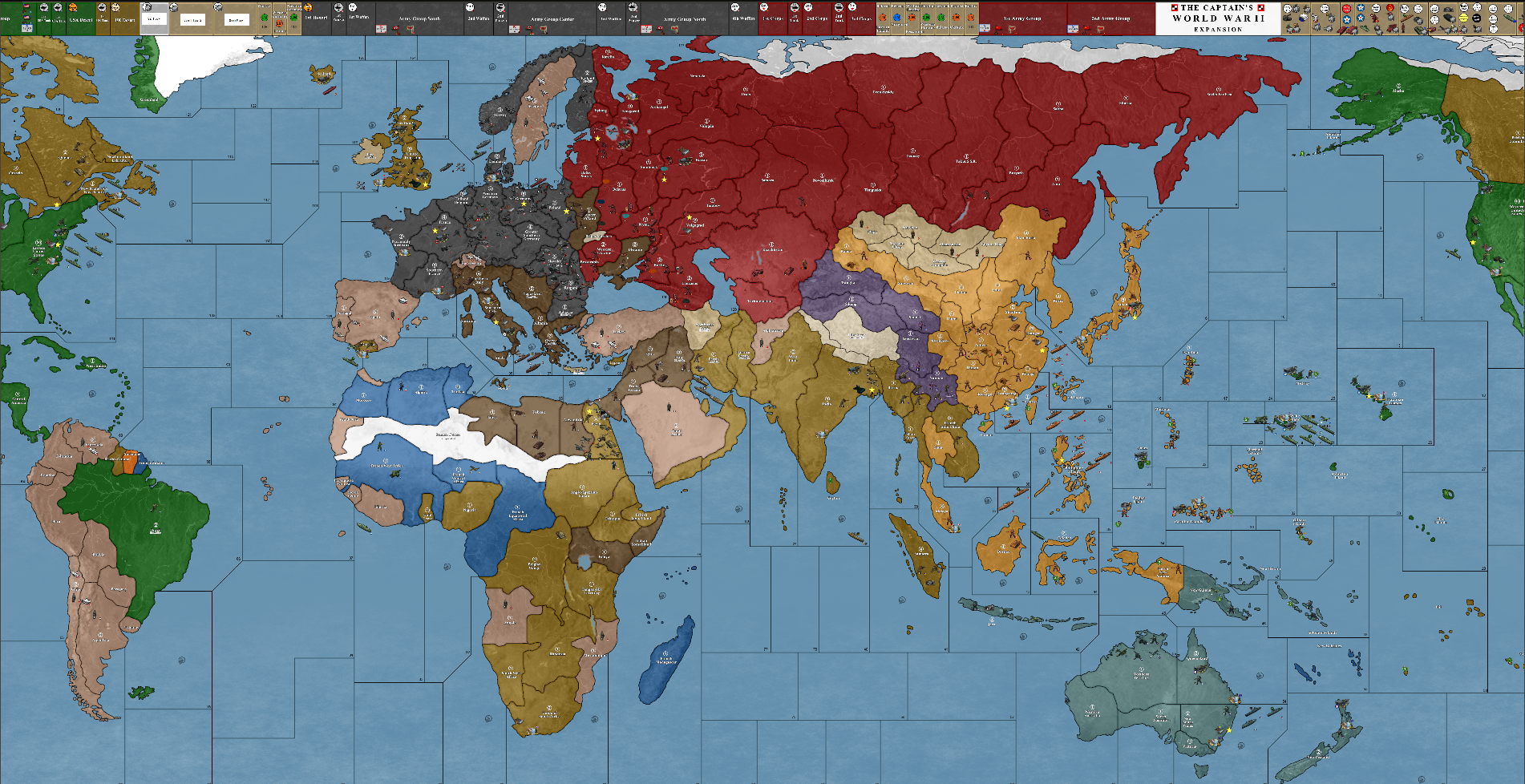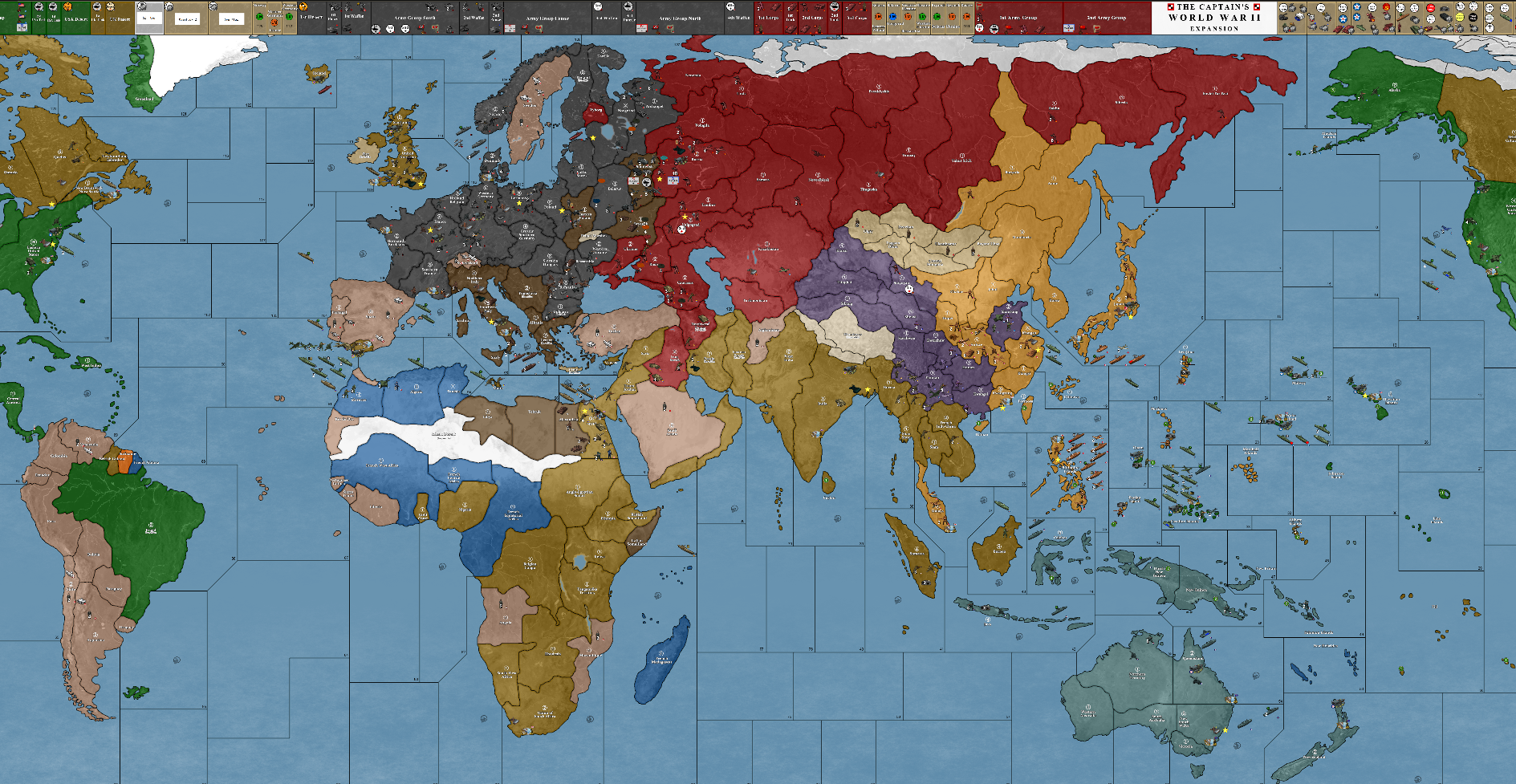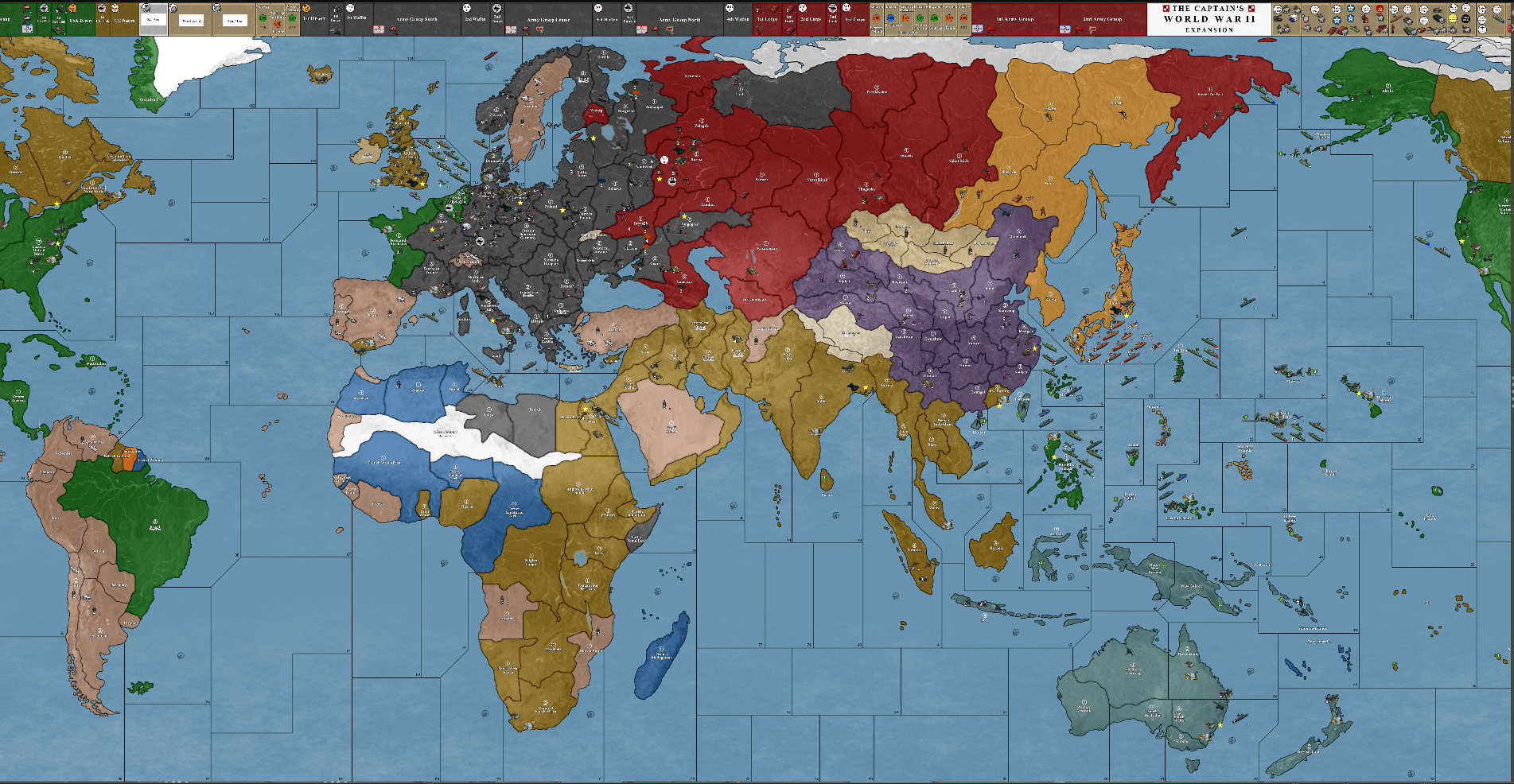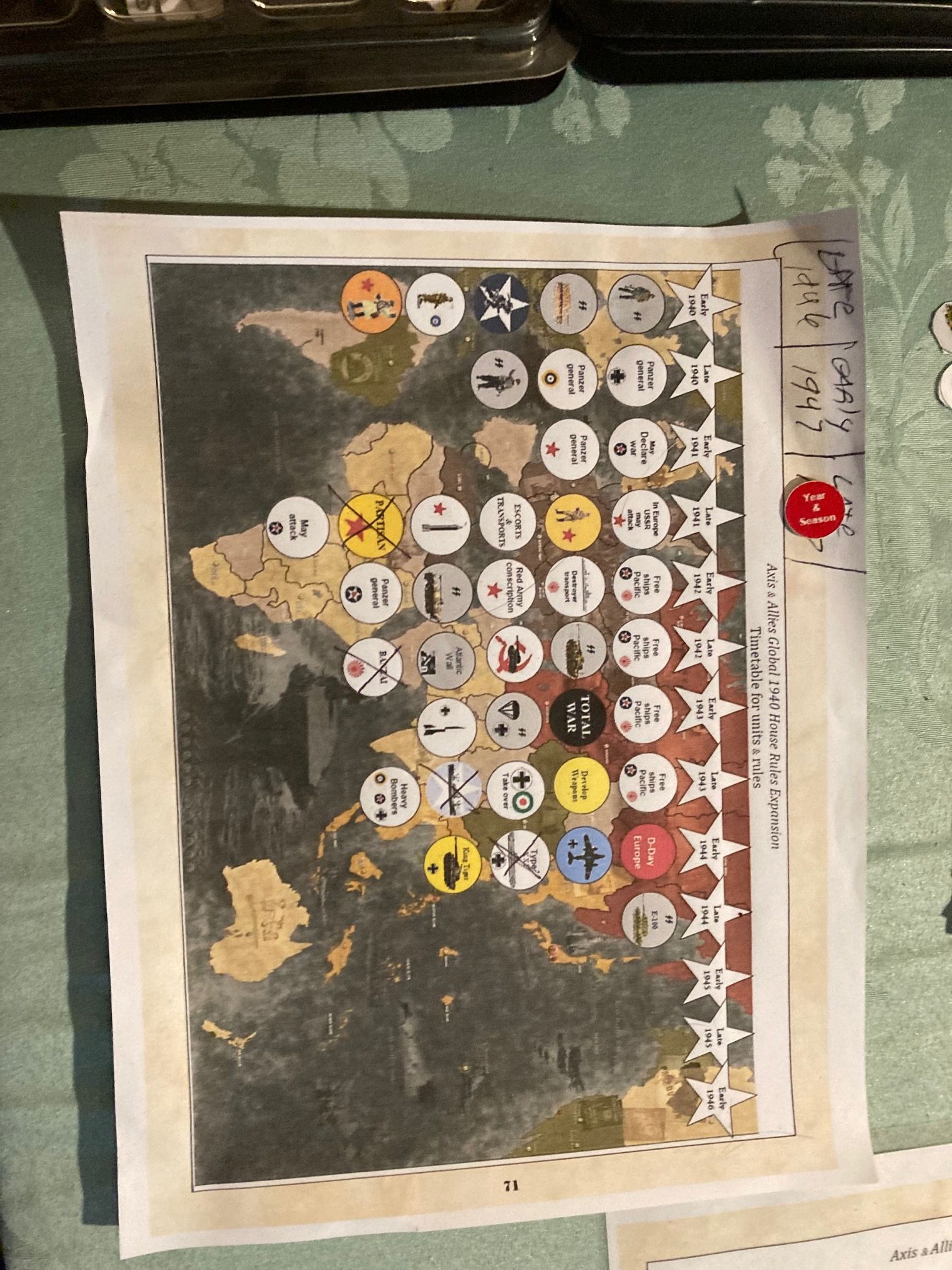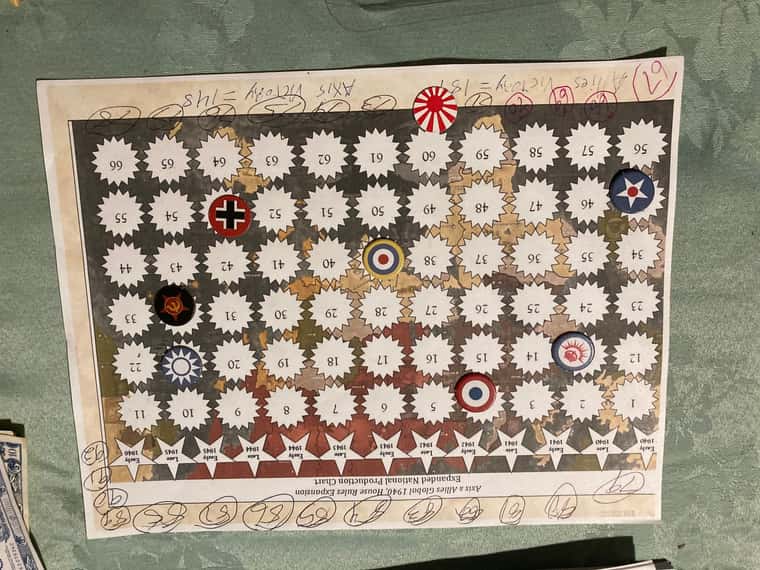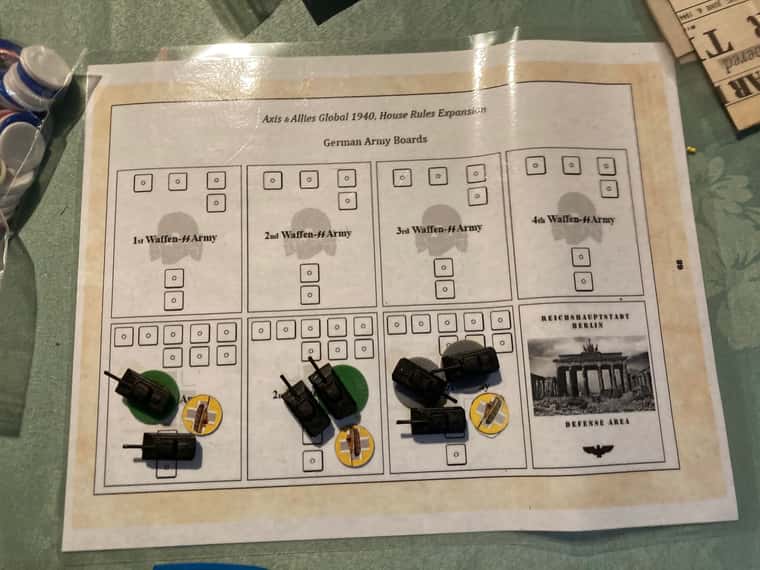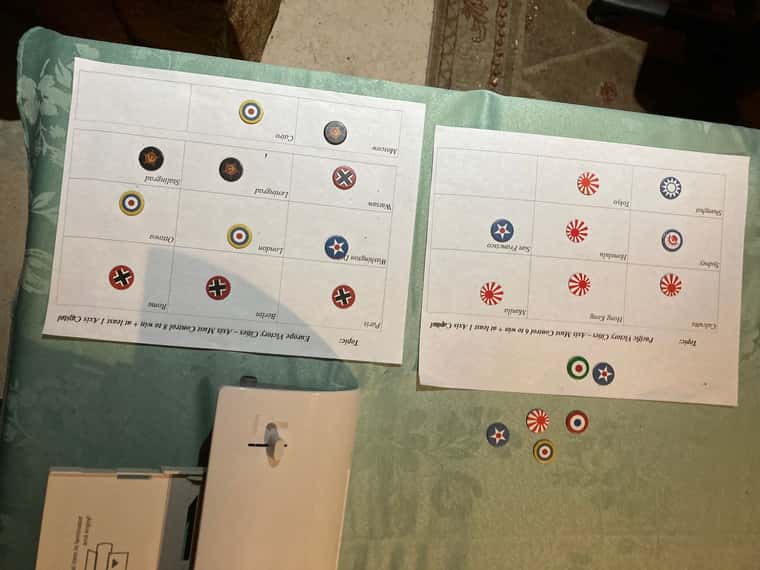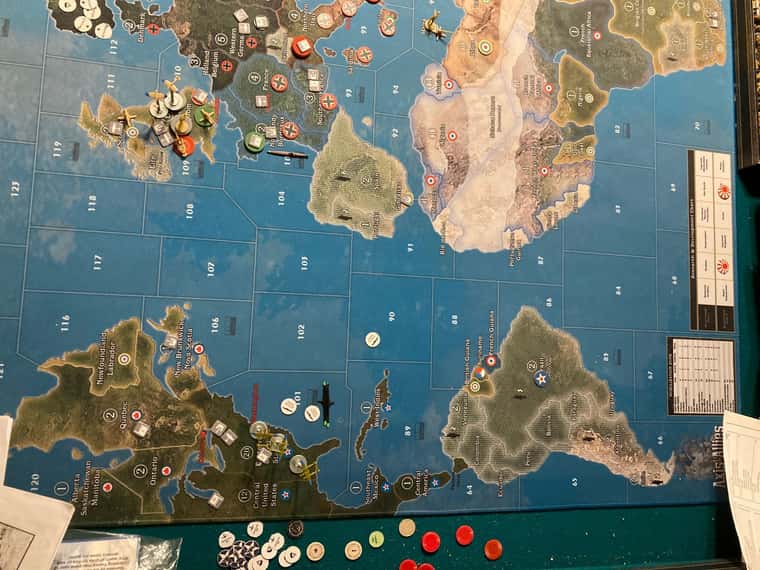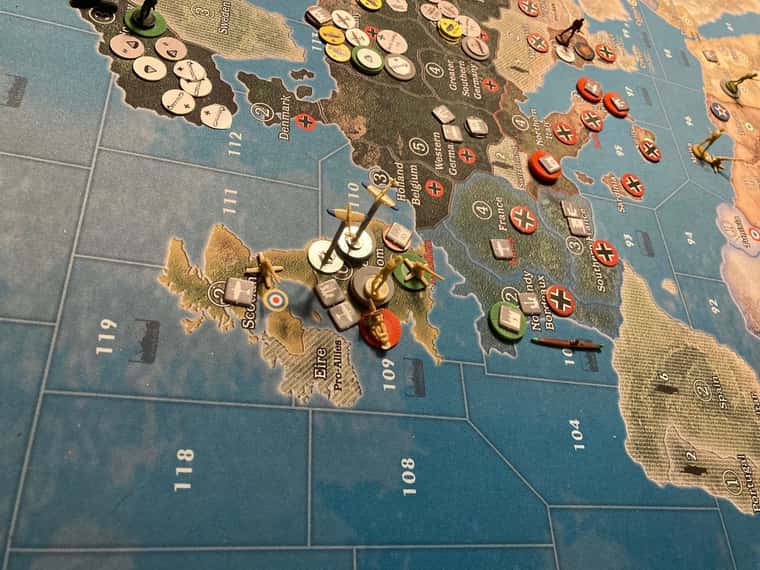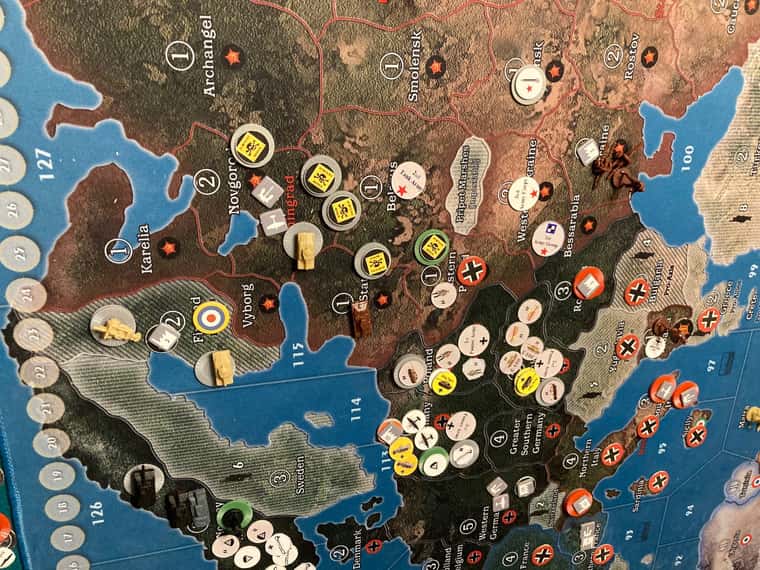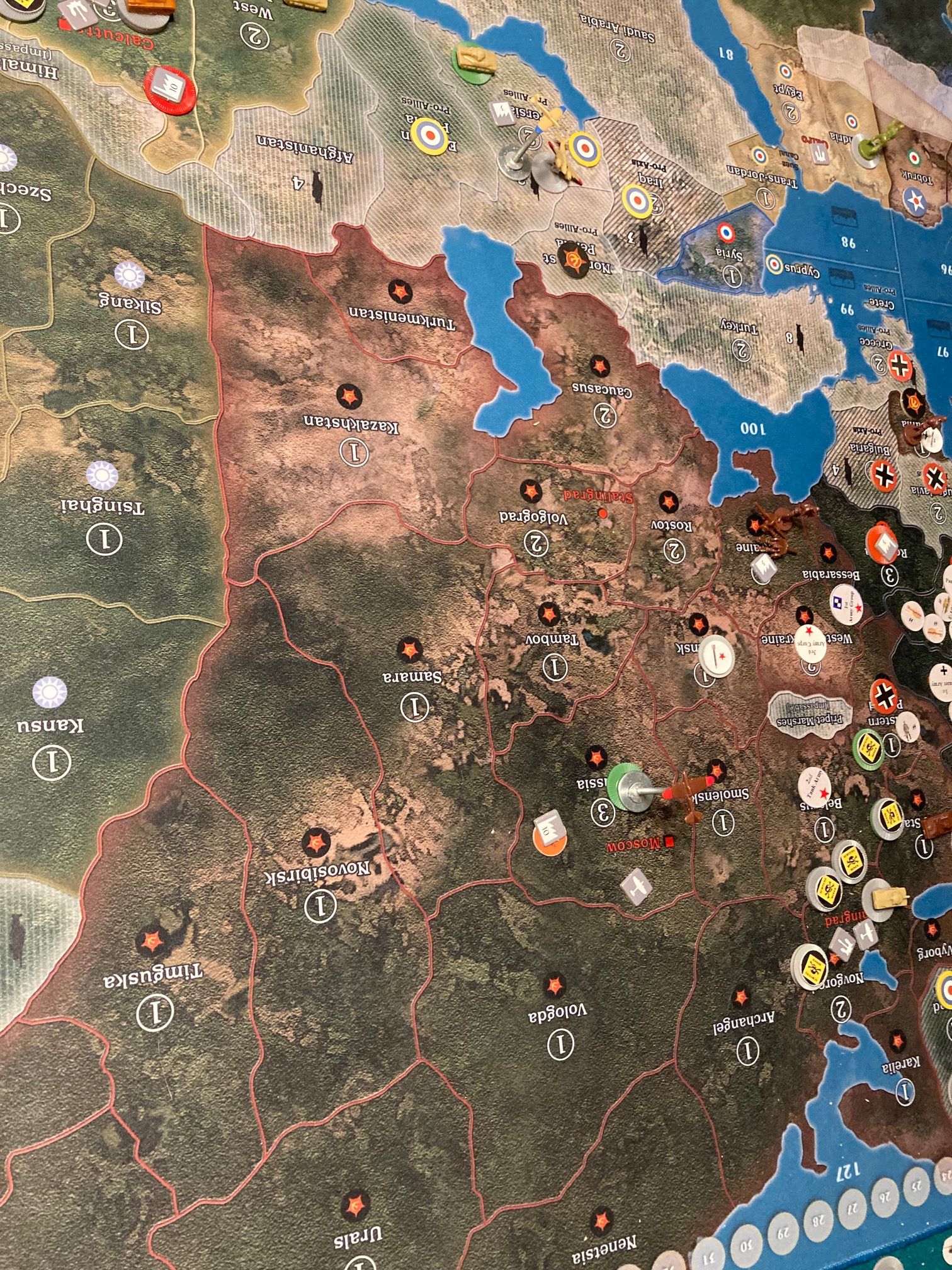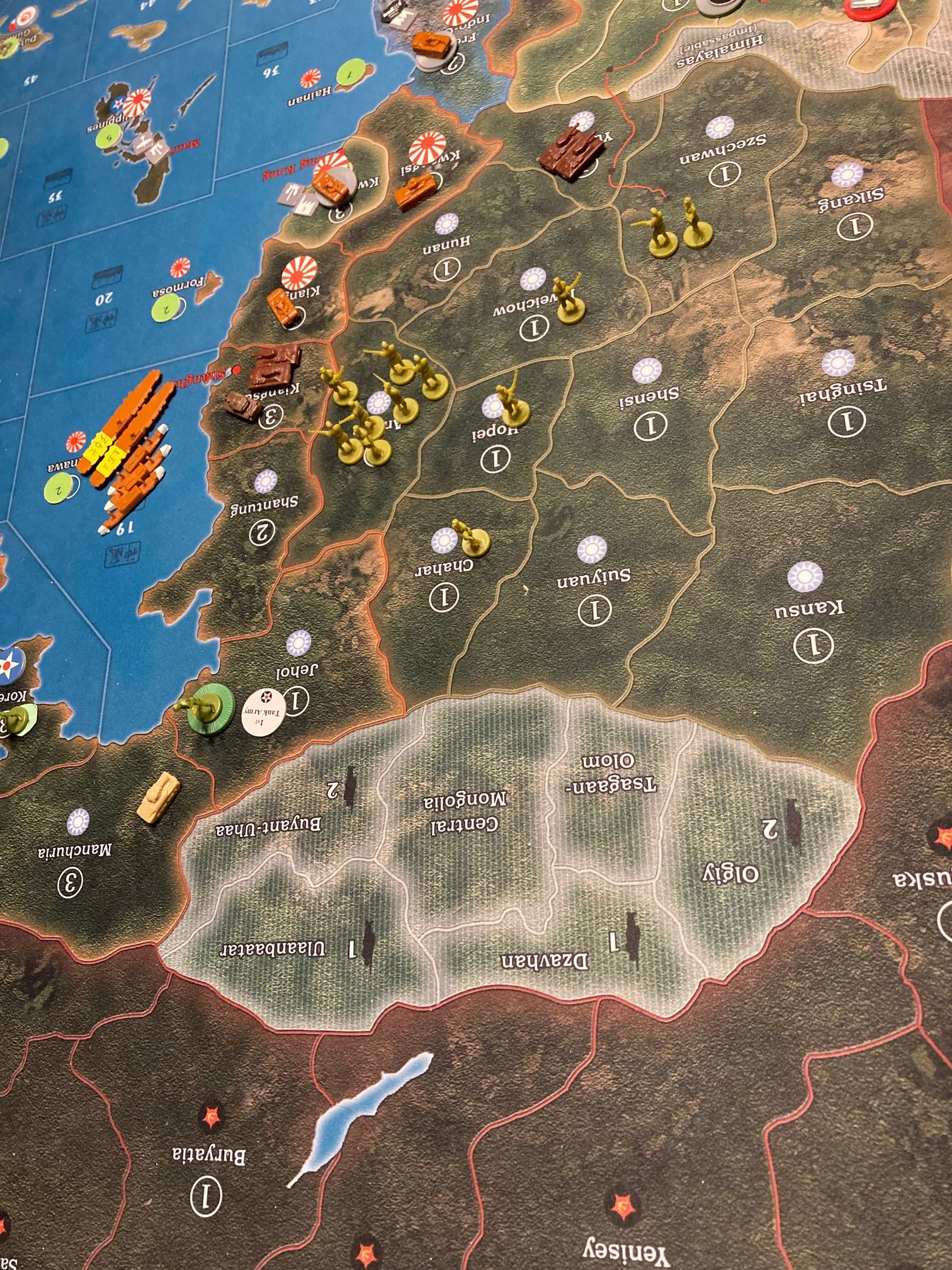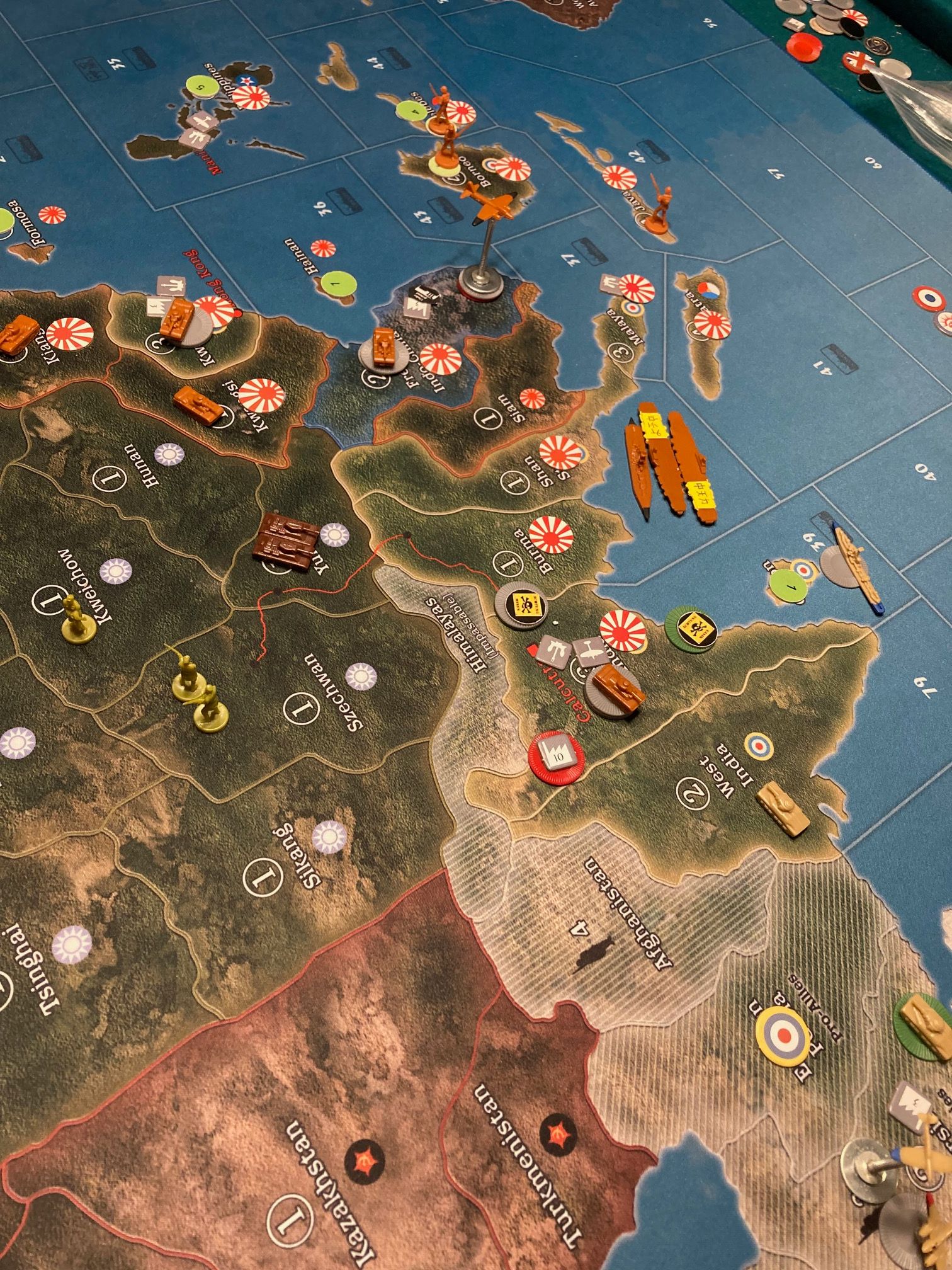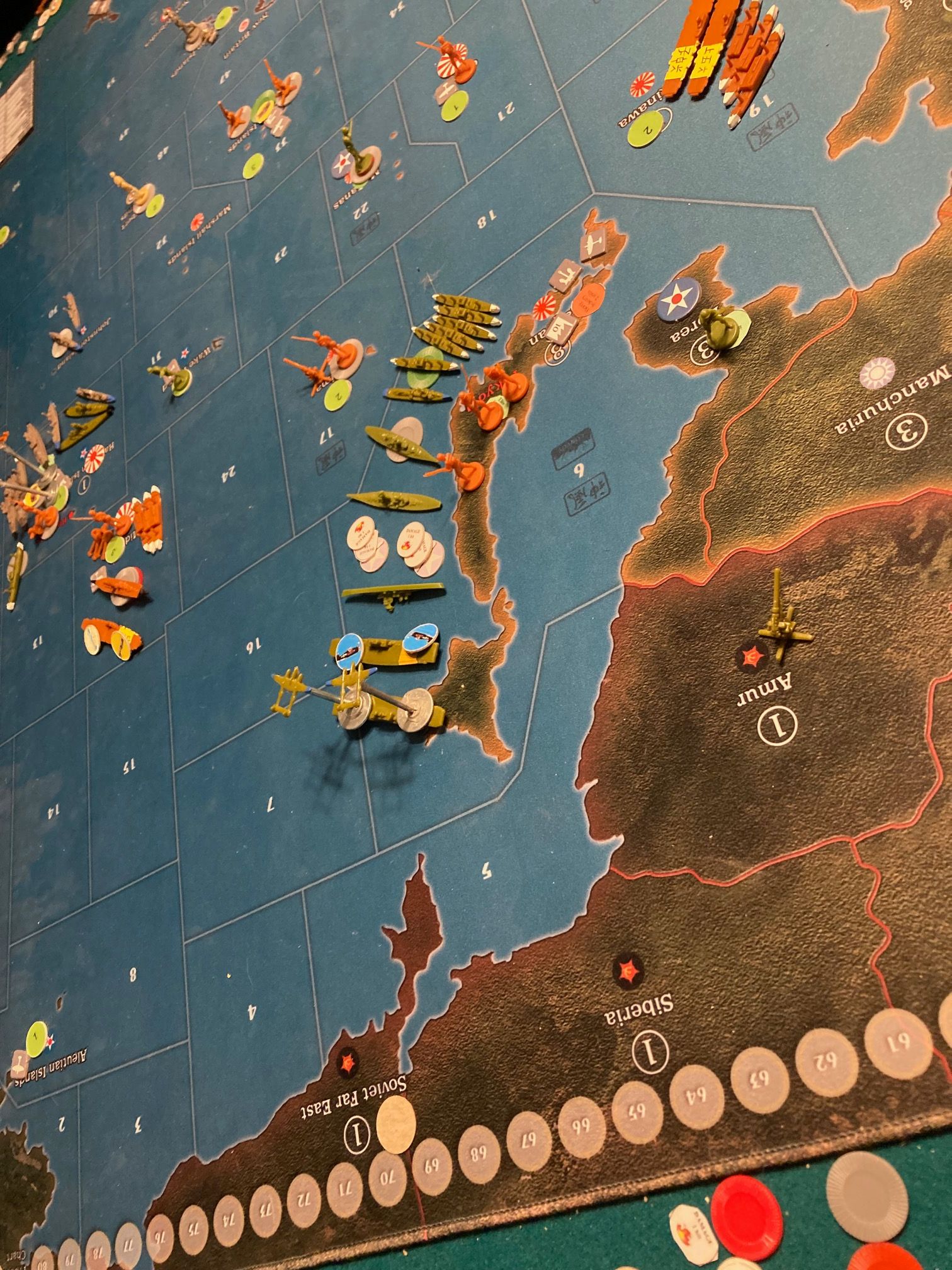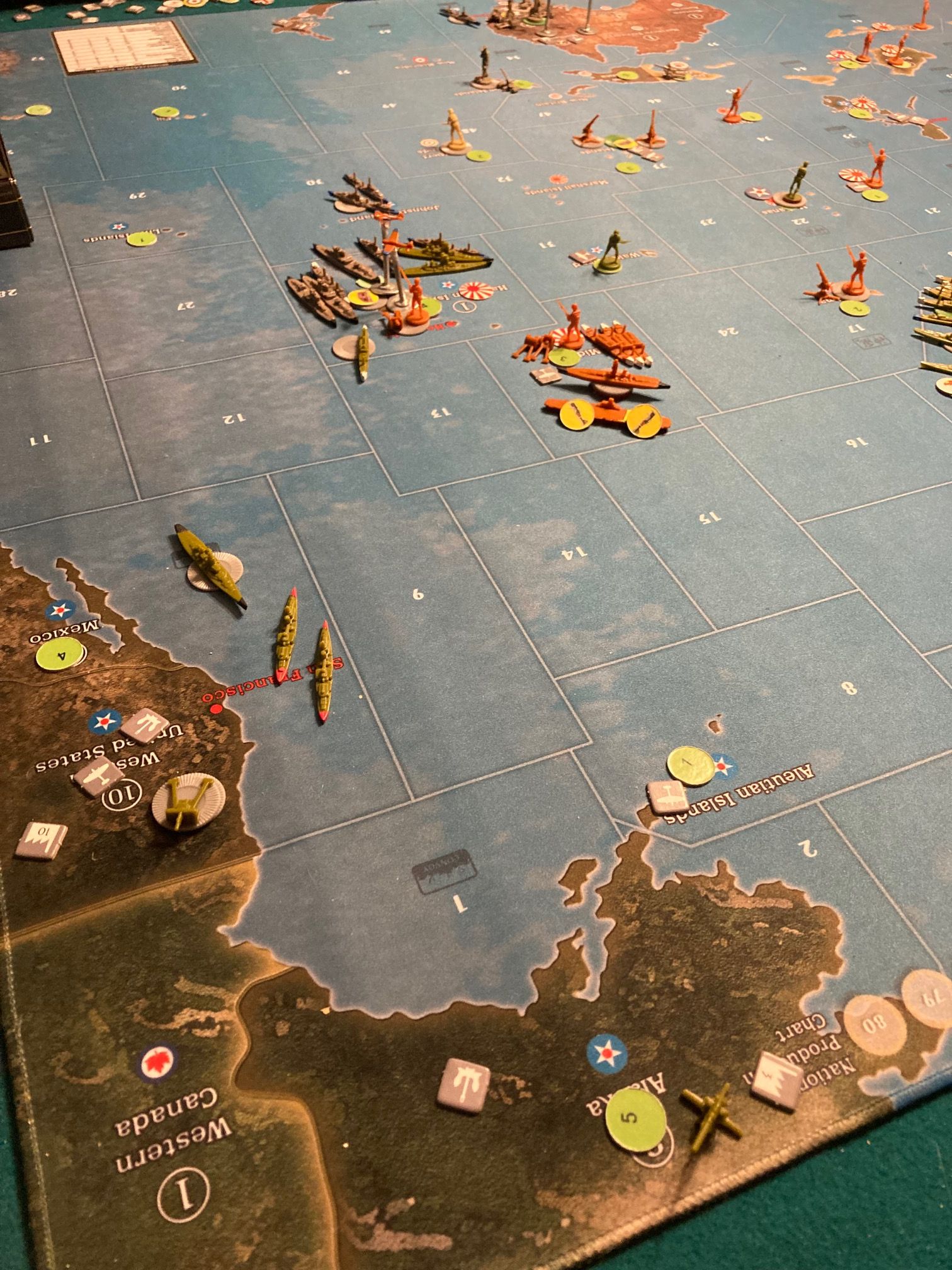Due to the fact that whilst most of your rules are historically accurate, their execution I have some problems with. To fix that, I wrote an article on changes to The Captain’s rules:
Global 1940 & 1943 Expansions Game Reports
-
The German LCV units were split up, so there were continuously 2 to 4 LCV units in Western Germany in order to support Norway - and still keep the British busy with defense in London.
2 LCV units were transported by Strategic Rail Movement to Greece - to either attack into Southern Russia or Syria to keep the German forces in the Middle East supplied.
The Allies might be able to win the War economically early in the War - if the Axis are not aware of the danger.
In Asia and the Pacific only China, United Kingdom, ANZAC, France and the Soviet Union can attack Japanese troops in until Late 1941 - so it is a major task to knock out the Japanese and to get enough IPC to win the War without support from the USA.
In Europe the Soviet Union and the United States also cannot attack until Early 1941 - so by then, they must be ready for a Full Scale Massive Offensive to be succesfull.
A solution could be to attack the Strict Neutral Nations - but if it fails, the consequences would be disastrous and the War would most likely be lost.
And again - succes depends on Surpise and Deception from the Allies - if the Axis find out in time, the Allies must have a Plan B.
-
Nice win for the Axis forces,
And also impressive to achieve a victory like this concluding all of Africa and the Middle East for the Axis.
It seems like the Japanese navy did not lose a single transport ? 12 transports still alive.Butt I see lots of errors from the Allies player.
Please correct me if I am wrong.
I know the pressure can be very touch and a mistake is very fast to make butt ,
( that’s the nice thing about these game reports, you can visualise and watch the game reports very good. And see what tactics are used and learn something )
First of all:-
The factory in South Africa was not made underground and been destroyed.
-
The harbour on Kwangtung is still intact.
( also on the phillippens both harbour and airfield still intact !) -
The US should invade Africa immediately instead of Normandy.
-
A lot of German u-boats on convoy raiding.
-
The US fleet in seazone 25 not able to free up New Guinea.
-
No lend lease fighters where send to Russia?
-
No heavy battleships in service for both the US and the Japanese navy?
-
Russia is able to build at least 8 partisans in the next round. In 8 different areas
-
The British Royal Navy consist of one submarine ? At this point in the war ? What happend here ?
-
-
Great game report! The Axis certainly seemed to put up a fight.
Love how you have two pictures directly below each other to show the full longitude of one theater.
-
SuperbattleshipYamato 2024 '23 '22last edited by SuperbattleshipYamato Aug 12, 2024, 1:42 AM Aug 12, 2024, 1:41 AM
Brilliant game! Definitely a shorter one.
Still undefeated in these game reports, I see. Nice Axis win. Especially impressive given how the Soviets have been unable to hold on to most of their territory. Real close early on.
I’m curious. What specific territories did the Allies am for early on to try to get that economic victory? How did that differ from other games? Thank you!
-
I don’t think Kwangtung Harbor that important. Can reach Carolines, but I don’t think any land units gonna be there to transport.
Not sure what went down in S AF, but I’d go Hvy Ind over Underground and destruct. Maybe you meant that point in time as the Reich was heavy in Africa :)
Yea, probably a good idea to dust that PHI Harbor.
Anyway, I guess we should switch to strat thread if we continue discussion :)
Hey, if you wanna give triplea another try, Victory says he’s up for it :)
You should brother. There’s a learning curve, but you’ll totaly dig it :) -
The United Kingdom shipped 2 Fighter units and 1 Tactical Bomber unit to the Soviets (Caucasus) in Early 1942.
A German Paratrooper assault eliminated those Lend-Lease Air Units in Late 1942.
Fresh Lend-Lease units were not able to get through the German frontline units at any time again.
-
The Global 1940 No. 17 Game Report is expected to be released in Late 2024 as soon as the game has ended.
-
Global 1940, No. 2 Game Report:
This is the only post in the No 2 Game Report.
Players:
Axis: Cornelis Post
Allies: BeserkerThe game has endend after Germany, in round 10
IPC Income round 9
without Bonus.The Axis 141.
The Allies 128Germany:
Germany attacks Russia in round 3, the Italians captured Caucasus in round 3.
in round 4 with help of the Italians a huge force was on Caucasus, also one German tank army.
after this the axis held the Caucasus for several turns, the Axis quickly conquered the middle east.
In round 9 the Allies were able to defeat the last German forces in the middle east,The desert army was:
One Tank army
One waffen ss army. ( dropped with air units)
and 10 infantry.
Because of the allies strategy to build no navy at all in the Atlantic,
the Germans saw a perfect chance to execute Sealion after the take over.Soviet Union:
The Sovjet Union was under heavy pressure from Germany at the start of the game, butt because of the axis invading the middle east, this was relieving for the Russians.
in the following turns the Russians are becoming very strong.
only 1 plane was successfully send lend lease.
3 planes from the English where destroyed by axis forces. (Also send lend lease)
The Russians where fighting a war of attrition.Japan:
The Japanese forces are building up a huge amount of transports till round 4,
they only build 1 factory in china in the early stages of war.
the Plan was to take as fast as possible the money islands and the Philippens.
The Japanese build up a huge forces in the Caroline islands, The US could not capture it the entire game.
In Round 9 the Japanese defeated the last remaining Chinese soldiers.
In round 8 because of the huge build up of transports the British soldiers in India must retreat.
They destroyed the factory harbor and airfield. ( first making the factory underground.)United States:
The US invented a new strategy to use air transport to move units to Africa every round.
which led to 50+ mechanized infantry in Asia and Afrika.
The only navy build was on the pacific,
The US navy in the pacific was a very strong fleet.
With one carrier with 2 fighter aces ass well.
The US was constantly looking to attack the Caroline islands. Butt at this point in the war it was no option till so far.China:
The Chinese Army was doing a great job and stead a very long time alive.United Kingdom:
The UK attacked the Italian fleet in the first round.
In the 2 round they attacked the remaining fleet of the Italians,
which led to no Italian navy butt also no English navy.The UK was heavenly reinforcing Afrika and also India,
Java where 10 infantry was dug in, in bunkers.Italy:
From Early 1940 Italy mass produces Landing Craft units, to invade Russia and the middle east.
The Italians where very poor in the beginning because of the massive attacks from the allies,
butt with help of the Germans the Italians captured the entire middle east.
They hold it for at least 2-3 round.with help of German U boats the Mediterranean sea was swept clean in round 3.
because of no allied navy the Italians held the bonus for 5 IPC the entire game afterwards for a clean sea.The Anzac,
Because of the Japanese attacks in round 4 the Anzac where very weakened,
The Anzac focus was to recapture islands and do convoy raiding.The Following pictures show the beginning of Round 10,
because London was captured, and the Allies could not recapture it, it was not necessary to complete the round after the German turnWith the take over germany pulled all troops back together with italian troops.
Italy bought 8 transports before the take over.
The Germans build 12 transports after the take over. Total of 21 transports.
And 5 landing crafts
So after the take over the UK has one round to buy units for London, butt the UK had 39 ipc at this point, so they purchased 9 infantry and 1 flak tower.Units involved in Sealion.
The Axis;
3 Fighters aces
2 heavy bombers
4 stuka’s
3 fighters
3 strategic bombers.
13 tanks
16 artillery
17 infantry ( also 1 elite )
2 combat engineers.
4 panzer grenadiers
5 landing craftsThe Allies
13 british infantry
1 elite
2 french soldiers
2 UK fighters
1 French fighter
1 tactical bomber
2 heavy bombers from the US
5 AA guns
a Flak tower.The flak tower scored 2 hits, the total hits of the allied forces was 12
The axis hit 35 + hits in the first round.
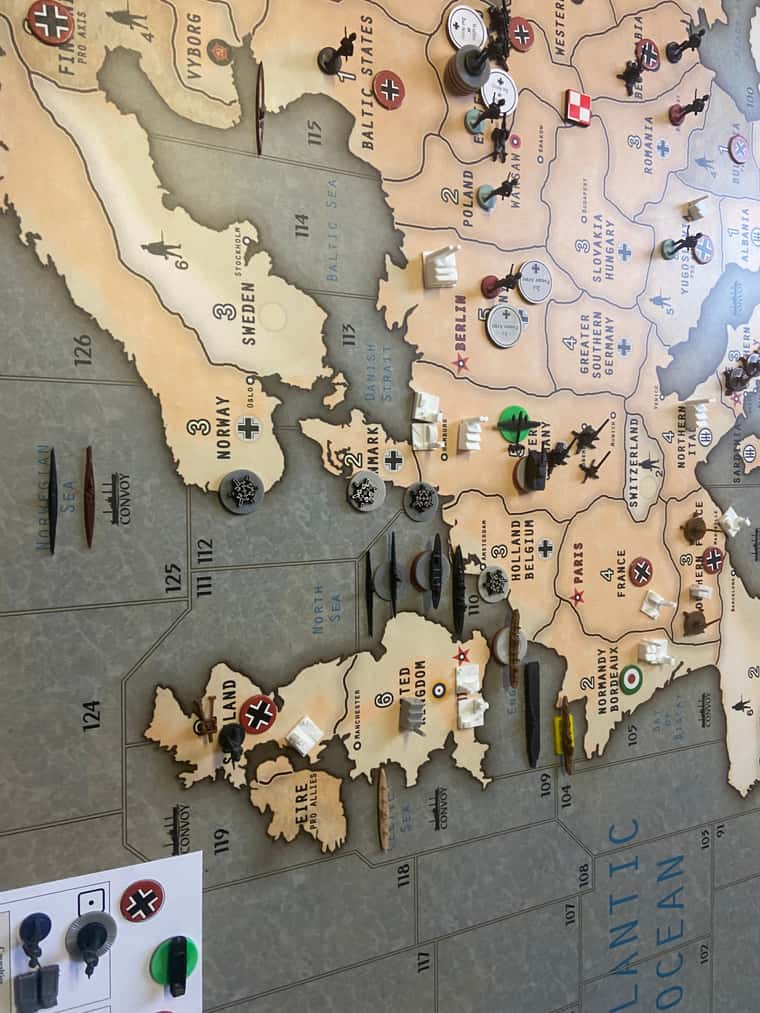
(/forums/assets/uploads/files/1724090220415-img_9136-resized.jpeg)
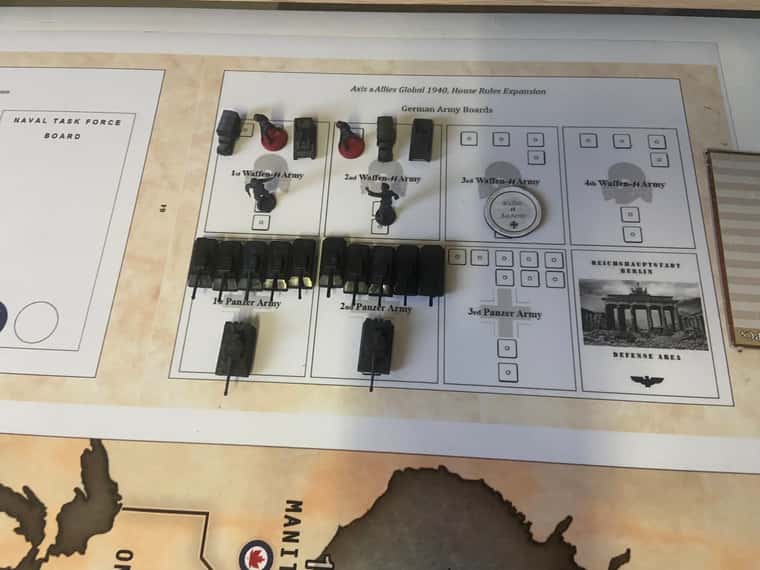
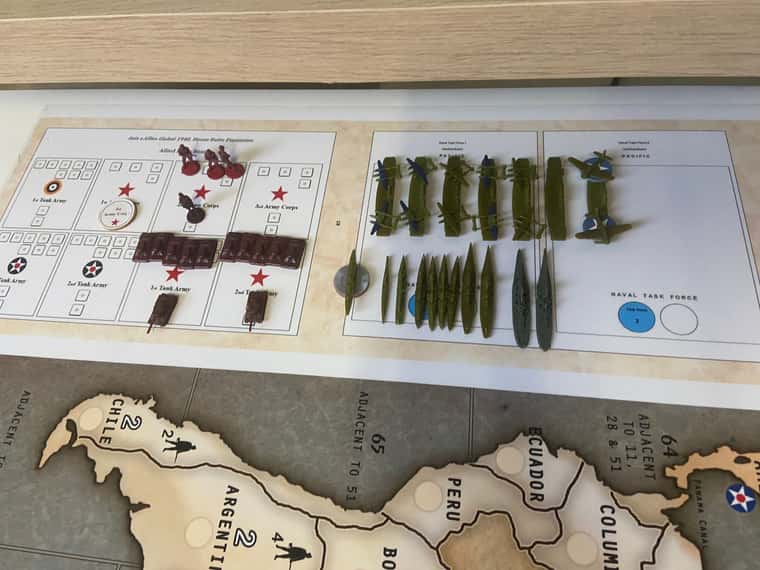
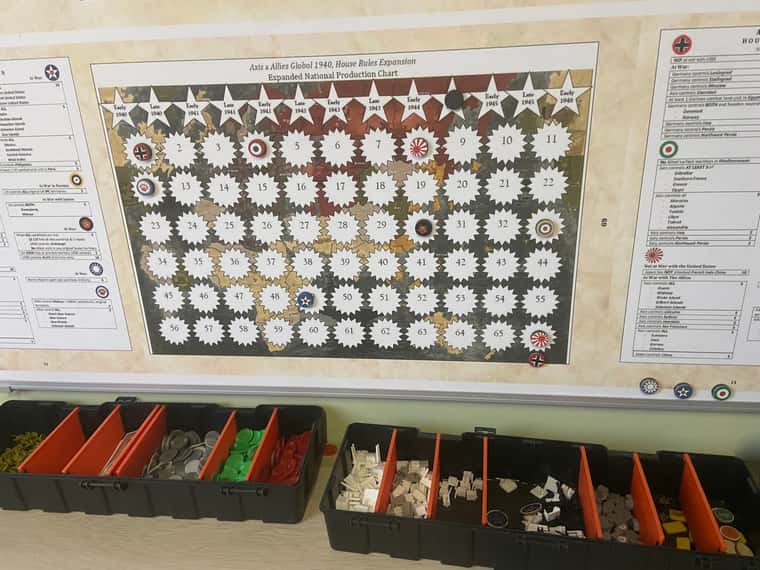
-
Very cool!
Nice to see an Axis victory with some variety. Isn’t this the first successful Sea Lion on this thread? I can’t remember, there’s been so many game reports over the years here (over 675 posts!).
-
Yes it’s the first successful sea lion attack.🙌🏻
-
Nice of the saudis to let the Allies park there planes in the desert :)
Did the Kriegsmarine convoy the Atlantic hard then ? Did they threaten USA zones ?
-
In the previous round all u-boats retreated.
So when Germany takes London there would be more money 😎Like 5-6 u boats did convoy raiding.
The last 4 rounds the UK lost every round at least 10 ipc
And Yes the German u-boats attacked US convoys butt only 1 time.The English defeated the sub with a destroyer and a tactical bomber.
-
Devious!
-
Global 1940 House Rules Expansion Game Report
via TripleA
Axis: barnee
Allies: VictoryFirstLink to our game thread: https://www.axisandallies.org/forums/topic/41097/5-barnee-axis-vs-victoryfirst-allies-g40-house-rules-expansion-by-the-captain
Save file: exp-game-5b-victory-allies9.tsvg
Barnee and I just finished our 5th game. It was an awesome game so I will try to write an awesome game report about it 😀 The report will be broken up into three parts, each consisting of three rounds of play.
Early Game (Early 1940 - Early 1941)
Germany:
The Germans did a standard waffen-buy with an elite and 4 U-boats. They made standard attacks against France and attacked both Allied fleets in SZ 110 and SZ 111. All attacks went well except for the Paris one, where they lost a bunch of units due to bad rolls, and the SZ 111 one where the poor-performing Luftwaffe broke off the attack and let a damaged HMS Hood sail away.
They invaded Yugoslavia but retreated after round 1 so that it was an easy walk-over for Italy.They continued to build up their Kriegsmarine with some U-boats but they also reinforced the Heer with Waffen units and Panzer-grenadiers.
Russia:
The Russians went mine-heavy this game. They purchased a shitload of mines along with two combat engineers so that they could move and dig them in more easily.They set up a dynamic defense with units in the West and the East.
Japan:
Hirohito surprised everyone except himself by declaring war on the Allies on turn 2. Naval bases in Kwangtung and Malaya were captured still intact, however the Philippines attack was a disaster for them. Due to a communication breakdown, two infantry in Kwangsi didn’t take part in the attack, and together with some bad rolls, they did not manage to take it while suffering heavy casualties.
In Early 1941 they continued expanding by taking parts of the Dutch East Indies and advancing further into China.United States:
After the defeat of France, Roosevelt didn’t like the look of Hitler and was therefore poised to go heavy on Germany the moment they were able to join the war. However, the early Japanese surprise attack forced a response and therefore threw a wrench into the American plans. They increased their Pacific naval production significantly and quickly formed a large fleet to counter Japanese aggression. A naval base in Wake Island was constructed to help with their logistics over the seas. Still, Germany was not forgotten and the Atlantic saw some large reinforcements too.United Kingdom and China:
Admiral Dudley Pound was delighted to see the HMS Hood still being around and moved him to Iceland, only to see him become part of the bottom of the sea anyway by a German U-boat attack.Attacks against Ethiopia and SZ 96 were made to slow down Italian expansionism. Nevertheless, the Italians quickly stood with a large army on the doorsteps of Cairo, with some help from the German Luftwaffe. A factory was built to stop their advance, however, with the railroad connection between South Africa and Cairo cut, preventing vital reinforcements from coming, it was uncertain if they could withstand the massive sudden pressure from the Axis forces. Therefore, the British built another factory in Persia in case Cairo wouldn’t hold.
An early Japanese attack allowed early British entrance into China. Yunnan saw some heavy reinforcements by Chinese and British forces, to ensure that the Burma Road stayed open.
Italy:
Italy did standard stuff, focusing on Paratroopers and LCVs. They made a sneaky declaration of war against the Russians in Early 1941, opening up ways of attack for the Germans.The British had to scramble for troops to defend Cairo, but in the end, it proved to be just enough to hold out. The Italians then moved away from Cairo and turned their eyes to the Middle East.
ANZAC and France:
The Australians produced a mixture of land units, destroyers, and transports. They also upgraded their Sydney factory to heavy industry to maximize the number of units they could bring against Japan.The French managed to kill an Italian sub in the Med, but their boats inevitably got destroyed by German Lufwaffe.
Click here to download a high-resolution PNG file of the map at the end of Early 1941: Early 1941.png
Mid-Game (Late 1941-Late 1942)
Battle of the Atlantic:
The Germans started gradually decreasing their investment in U-boat production as the war against the Soviets required the most attention. The U-boats did limited damage to the British shipping and were quickly swept away by Allied naval task forces, consisting of numerous destroyers, a US Heavy Battleship, and two carriers. By Early 1942, most of the U-boats were already destroyed, and by Late 1942 the Allied fleet was entering the Mediterranean.Eastern Front:
Because the Russians had numerous units operating elsewhere, the Axis were able to make a strong push into Soviet territory. The Russians avoided large-scale conflict and mostly retreated, while digging in numerous mines on the frontline to slow down the advance. However in Late 1942, the Germans were able to move almost their entire army to Smolensk, putting a lot of pressure on Moscow.Africa/Middle East:
After a short siege of Cairo, Italian troops started marching to the Middle East. They also scooped up a not-very well-defended Gibraltar in Late 1941, although it was recaptured by the Allies the next turn. At the end of round 4, they were at the peak of their power, collecting 37 IPCs.
The Persia and Cario factories were bombed by German Luftwaffe, as well as the naval base. The British moved the Persian factory underground to avoid further bombing. Their complexes were running at full speed to reinforce the area. In Early 1942, the Russians supported the British in the Middle East, and destroyed an Italian corps in Northwest Persia, and also captured Iraq with a paratrooper assault, giving them some extra income (also a +3 bonus because it is a pro-axis territory). After a subsequent British attack, all Axis troops in the Middle East were eliminated.
With the Allied fleets arriving, the Italians started preparing for a German Takeover and used the rest of their forces in Africa to make a suicide attack against Egypt.Asia:
Things started to go wrong for Japan as the Soviet Union made an early declaration of war against them in Late 1941. A Soviet Army Corps entered China through the Sinkiang mountains and caught a Japanese contingent in Kansu off-guard with a surprise strike. They also invaded empty Korea, but the rest of their forces stayed put in Amur to preserve strength.
Yunnan turned into a defensive stronghold and the Japanese were unable to take it. This gave the Chinese much-needed resources for the war effort, and they were able to turn the whole front into a stalemate, with the Russians supporting in the north.The Japanese factories in Shantung and Kiangsu were producing combat units at full speed, however they were simply getting outnumbered and to make matters worse, in Late 1942 the Americans were able to land in Shantung, destroying one of the complexes.
Pacific:
The swift victories in Early 1941 were quickly shoved away when the Americans captured the Caroline Islands with a sizeable fleet. The Japanese, running out of landing forces, weren’t able to take the well-defended islands of Sumatra and Java. They instead reinforced the IJN with two Yamatos and later with another carrier. Both fleets had a stand-off for a while, staring at each other from a distance of around 3000 km 😀. The Japanese faced a lack of screening ships, allowing the Allies to make amphibious landings with transports.
By Late 1942, all of the Dutch East Indies had been liberated.Download a high-resolution PNG file of the map at the end of Late 1942 here: Early 1942.png
Late Game (Early 1943 - Early 1944)
Asia & Pacific:
The war has now seriously turned against Japan. They are being outnumbered on all fronts and are unable to hold on. They managed to recapture Shantung but were forced to abandon the Philippines. The superiority of Allied screening ships became prevalent as they were swarming the Pacific, blocking off the Japanese fleet in SZ 6.
After another Allied landing - this time in Kiangsu - the second Japanese industrial complex in Asia was destroyed. By Early 1944, they lost most of China as well as numerous Pacific islands. However, they eventually did manage to make some gains against the Russians in Siberia, but it was too late.Europe:
With the poor show-off from Hirohito, Hitler knew he had to pull the trigger to have a chance of victory. Not the trigger of his Walther to shoot himself (😂), but the order to make a large push against the Russians. The Germans prepared for Operation Typhoon and made moves to encircle Moscow.
The Russians were significantly weaker because they sent large army formations to help in various areas of the board. 3rd Army Corps was still chilling in China, the Soviet infantry army in the Far East was having some clashes with the Japanese, while the Soviet Middle East army was making its way back home. Still, Stalin ordered his generals to avoid retreat and make large counter-attacks against the German spearheads. All attacks were successful, but in the heat of all action, he forgot one important thing, and that was the defense of Moscow.Late 1943 was a good turn for Axis Germany. Italy was about to be taken over and the previous turn they made attacks with Paras and landing crafts against the Caucasus. After the Takeover, these units became German and were able to attack again, causing a disaster for the British in the Middle East. They were ill-prepared against this move and therefore hadn’t set up good defenses. Using SZ 128, the Germans were able to capture Persia and its factory, as well as Iraq.
The German generals grabbed their calculators and computed the odds of a German attack against Moscow, getting a result of 55-60%. Given the inevitable downfall of their Pacific ally Japan, they decided against it and mustered all of their units for a final push. The Soviets defenders were caught by surprise and missed a bunch of their rolls. After the dust had settled, the Germans were driving around the Kremlin with an intact panzer army, two waffen panzers and one German plane. A terrible defeat for Stalin, who blamed his generals for the disaster and executed them.
Still, the Russians had several units around Moscow and were able to recapture Moscow, although the loss of the capital was a big blow for them, together with the loss of the British factory in Persia, which deprived them of a direct supply line of Allied fighters. Fortunately, they managed to keep a path through Novosibirsk open so that British units from China could still rail to Moscow. The Germans were scrambling for troops to have a chance to deliver a crippling blow to them.
In Early 1944, the Germans weren’t able to muster enough troops for a second Moscow attack and were getting pushed out of the Middle East and the Caucasus by the British. Persia was liberated, although not before the Axis destroyed the underground factory there… (cheeky move 😀)
The Allies, after having built up their strength for several turns, now finally made a large-scale landing in Holland, with a US tank army and large amounts of fighters and bombers.
However, they didn’t get to fight any further because the Allied income at the end of Late 1944 reached a level of 194, thus ending the game.
Download a detailed PNG image of the final look of the map here: Early 1944.png
Post-game commentary:
Funny enough, this game showed a lot of resemblance with our 3rd game. In that game, the game also ended on turn 9 due to an Allied Economic victory, Japan got beaten back pretty badly, and Moscow got captured but it didn’t change the outcome of the game. All these things also happened in this game, even though for the most part we employed different strategies. As the US, I tried to go more or less 50/50 on Germany and Japan. I wanted to go after Germany at first but with the early Japanese DoW, I had to do some stuff against them as well. In many A&A games, this strategy usually doesn’t work, but in the Expansion, it worked out pretty well, which I really like!Unfortunately, I made the same stupid donkey mistake of letting Moscow get captured. Now that it happened again, I will try to make sure the defense of Moscow is safe above all things. It can’t always go right!
I now think Turn 2 is too early for Japan to attack. At first, I thought it was the best turn but after this game and the game between me and Panzer, I’ve changed my mind. Early on their empire is kinda unstable so they are vulnerable to attacks. If the Allies put enough pressure against them from all sides, Japan could have some serious problems very quickly. Above everything, they should prevent the Allies from forming a stack in Yunnan which I think is the worst thing for Japan ever. If they attack Turn 3, Turn 4, or even not attack at all, they have more time to focus on China and prevent this.
From now on, barnee and I will play our games on the TripleA forum, however we will still write reports here in this thread.
@barnee Hehe already looking forward to the next one 😁 Feel free to share your thoughts on this game as well if you want!
-
Heh heh well done Victory. You’ll have to PM me and show me how you got the entire map in one photo. :)
For those that dl it, you can magnify and cruise around anywhere you want, with the scroll bars or arrow keys.
Nothing to really add. I’ve always been a believer in trying to get as many “boots on the ground” as possible. However, the Naval support ships are quite impactful.
At any rate, I need to adjust some things. I believe this my 3rd defeat in a row and 4 out of 5 including Panzer :)
Oh yea, you qualify for the free Paratroopers, as this our 5th game :)
Edit
Yea, I was hoping to get the Islands early with J2 attack. It’s worked in practice games, but obviously, an opponent other than myself has something to say about it. :)PHI was a massive failure, but Idk if even it worked it would’ve been successful.
-
SuperbattleshipYamato 2024 '23 '22last edited by SuperbattleshipYamato Sep 14, 2024, 5:33 AM Sep 14, 2024, 5:18 AM
Sad that the Axis lost but glad that you, the less experienced player, won (I also kind of consider you a friend after what feels like 5 games with each other).
Classic scorched earth in the end at Persia, loved it. The game report managed to be informative and detailed without being goo long (though I’m certainly not one to judge the length of game reports).
Quite a long salient in the southern USSR over there. The Axis looked better in certain places (Europe) and worse in others (Pacific and Asia) compared to their position historically.
-
Global 1940 July 4th 2024 Game (start) report #3
(3rd day of play)Global 1940 with Expansion Rules & the following optional rules:
Rockets
Heavy Bombers
Seafire fighter planes
Jet Fighters
Japanese Destroyers
King Tiger & SS Heavy TanksAgreed a win can happen through Economic Victory or Axis capturing victory cities per the original Global 1940 rules.
Germany - Josh S
Japan - Alex M
UK - Pat H
Russia - mkgionet
USA - Mike K
Report from Early 1945 (round 11) through Russian turn of Late 1947 (round 16)
Longest game I’ve ever played!General observation that over the course of these turns the game went from Allies having an advantage to Axis having the Allies on the ropes. Throughout all of these turns no side has been anywhere close to an economic victory. It was a wild day of play!
Germany
As expected, multiple tank armies and a plethora of other troops descended upon Russia’s Army Group wiping it out, but losses Germany chose to take disbanded both tank armies. Focused on reclaiming/owning all territory west of the Russian front, expanding northward, and creating a steady supply of wolf packs. When the UK and US lost (or retreated to the Pacific) what little navy they had left wolf packs rule the sea and have been sitting off of the US coast for several turns depleting US income 15-20 IPC every turn. A very effective strategy. Have now stabilized all fronts with the expectation of a new surge into Russia.UK
Took over the Finland factory that Germany built to boost the Allied presence in Europe. Paratroopers liberated Paris causing the creation of Vichy troops that walked into nearby territories that were left open by Germany, boosting the France economy to 22 IPC. Paris was quickly retaken however putting that income into the pockets of Germany. Tanks from the middle east and Africa travelled to the Allied front lines in China to help liberate it from the Japanese. India was a focal point of Japanese aggression so many resources were put into its defense, but it finally fell (without the possibility of immediately being reclaimed) in 1947. No D Day has yet taken place, and it doesn’t look like it will be happening anytime soon. Africa has been pretty much a non-factor for most of the game. Anzac has held its own.Russia
Spent almost every turn creating armies to send to the front lines, as well as a sprinkling of rockets and other units. After their Army Group was soundly defeated another army quickly took over Poland. Germany would soundly defeat them the following turn but leave Romania or Hungry vulnerable for Russia to walk in with another army into one or both of those territories. Several turns saw these territories changing hands back and forth between Germany and Russia. A steady stream of tanks and other troops were sent into China, finally reaching the Pacific in 1947 (more on this later). With the help of the UK and USA the Japanese invasion into the Eastern Soviet Union was squashed. A new Army Group was recently formed and is sitting on the front lines prepared to defend or attack Germany depending on what they do next.
Fun fact - Original Russian sub still alive and has been sitting off the coast of Normandy disrupting convoy operations for several turns.United States
Since the opportunity presented itself Rome was successfully invaded with minimal troops, and all surface German ships were destroyed. They were able to maintain this foothold for a couple of turns before Germany mounted enough troops to recapture it. Most of the US attention was on the Pacific, with only minimal forces on the east coast to try and keep the wolf pack population in check.The US built a factory in Alaska to filter troops into Russia that could push back the Japanese, including the formation of a Tank Army. A large fleet was built up waiting to see the best opportunity for attack. Although the US controlled the seas of the north Pacific, it left Japan to run wild in the south Pacific, and left India to fend for itself.
Japan
Certainly the strongest country for most of the game. Took over and held Hawaii, kept pumping tanks into China, and focused on taking India. Wasn’t able to keep up with the three pronged attack from UK, US, and Russia in China and has been pushed back to the coast. The last turn+ was incredibly exciting. In early 1947 Japan took India with the Allies having no chance of reclaiming it. This got them to 6 victory cities. The Allies had to recapture 1 victory city or the game was over. Japan sent most of their fleet south or east around Midway, “only” leaving a couple of super-heavy battleships and transports around Tokyo.The US had a massive fleet sitting off the coast of Alaska, with a sizeable number of troops. The allies could see that India was going to fall so it was clear that the fleet and troops in Alaska would attack and reclaim Hawaii since the US troops significantly outnumbered the Japanese forces. However, once the allies saw that Tokyo had such a small navy protecting it, and had less than 10 infantry (1 elite) & an AAA gun for ground troops, that was simply too good of an opportunity to pass up. The Alaska force was sent to Japan to flip the game so that the Axis would be in a desperate situation. Japan used all their kamikaze attacks but the US soundly won the naval battle. However, the Home Defense combined with great/poor rolling gave Japan the victory with only 2 infantry and an elite remaining. The allies took the bait, but it was a seriously risky move.
Even though the US clearly had the edge in Tokyo the allies had backup plans in place. The US also invaded Hawaii with a small amount of forces in the hopes it could weaken the Japanese there so that Anzac could win the day. That didn’t work out. The only hope left was Shanghai, where Japan had a sizeable force. The US attacked and weakened it, the UK attacked and weakened it some more, leaving it up to one last shot by Russia. Russia’s 4 tanks were easily able to overcome the remaining tank and elite infantry to (at least for the moment) save the day for the Allies.
Is the end still near for the Allies? We’ll see when we enter 1948 and beyond! (sorry for being longwinded)
-
Wow Exciting is right ! Awesome report !
I can’t remember how VCs work. They don’t add up at end of france turn ? The way Economic does ? So, how did the SSR get to go again ?
Boy Wolfpacks off the east coast of America ? Brutal lol Raeder is definitely getting promoted to 2nd in Command lol
I think the yanks need to sink them at all costs :) unless the VCs force there play elsewhere. Upgrade the AB in DC and build one in Central and uppgrade with Total War Ftrs for both :) heh heh A DD in each SZ
Sink those nazi bastards lol
Can’t tell the score 148 Axis ? 181 Allies ?
Great report. When do you play next ?
-
@barnee Thanks Barnee! For VC’s the Axis have to hold 6 in the Pacific (or 8 in Europe) for a FULL turn. So since they achieved 6 on Japan’s turn it has to get all the way back to Japan’s next turn to be considered a victory. That’s why if Russia didn’t succeed in taking Shanghai it would’ve been game over.
Great idea about building an air base in Central, need to seriously consider that.
Score is currently: Axis 125 Allies 154
Scheduling is tough so we probably won’t play again until early November.
-
ahh … thats’ right. I remember now :)
That’s cool, only a month maybe this time.
Keep us updated :)

